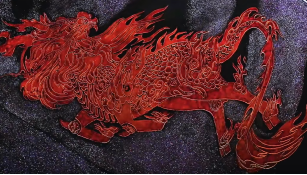千年漆艺:中国传统漆器的流光岁月

Traditional Chinese lacquer (漆) art, an intangible cultural heritage, refers to using lacquer to paint on the surface of wares (器皿) or artwork. The production process of lacquer ware is quite complex, with production cycles ranging from three to five months to one or two years. Raw lacquer is a natural liquid taken from lacquer trees. When lacquer is used for painting, it can resist moisture (潮气), high temperature, and corrosion. If you heat it and mix it with colors, you get colorful lacquer. Lacquer ware is not only pretty to look at but also very useful.
Lacquer art has a long history in China. Historical records show that China was the first country in the world to use lacquer. People started using lacquer ware as early as in the Xia Dynasty, about 4,200 years ago. By the Han Dynasty (206 BC-220 AD), lacquer ware was part of everyday life. In ancient China, there were many lacquer trees. The great philosopher Zhuang Zi during the Warring States period (476 BC-221 BC) was once in charge of a lacquer tree garden.
Early lacquer ware was simple, made from wood or bamboo molds painted with lacquer. As time went on, new techniques like colored patterns and liquid gold decorations appeared. Different dynasties had their own styles of lacquer ware. In the Han Dynasty, when lacquer art was very popular, there were things like lacquer boxes, plates, earrings, masks, and chessboards, mostly in red and black. During the Ming and Qing Dynasties, making lacquer ware reached a new high. During this time, lacquer techniques started to mix with building and furniture making, focusing more on looks. In the Ming Dynasty, lacquer carving was very common.
Today, the main places for making lacquer ware are Beijing, Shanghai, Chongqing, Pingyao in Shanxi Province, Yangzhou in Jiangsu Province, Dafang in Guizhou Province, Tianshui in Gansu Province, Yichun in Jiangxi Province, and Fengxiang in Shaanxi Province.
原创编写 版权所有 侵权必究! 每日更新 个性化阅读 英语飙升!